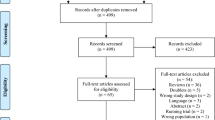Abstract
Although ketamine can induce a state similar to a near-death experience (NDE), there is a striking difference between experiences induced by ketamine used in a recreational context and in an operating room. Ketamine is a noncompetitive antagonist of the N-methyl-D-aspartate receptor, as is ibogaine, the main alkaloid of a shrub used in Central Africa to induce NDEs in a religious context. Ibogaine can also elicit different experiences when used in a hallucinatory context or in initiatic rituals, where a superficial state of coma is induced. These data raise the question of whether the chemically-induced NDE-like experience is related to the use of a particular kind of substance or to a genuine comatose state.
Similar content being viewed by others
References
Carr, D. B. (1982). Pathophysiology of stress-induced limbic lobe dysfunction: A hypothesis for near-death experiences.Anabiosis: The Journal of Near-Death Studies, 2, 75–89.
Collier, B. B. (1972). Ketamine and the conscious mind.Anaesthesia, 27, 120–134.
Deecher, D. D., Teitler, M., Soderlund, D. M., Bornmann, W. G., Kuehne, M. E., and Glick, S. D. (1992). Mechanism of action of ibogaine and harmaline congeners based on radioligand binding studies.Brain Research, 571, 242–247.
Domino, E. F., Chodoff, P., and Corssen, G. (1965). Pharmacologic effects of CI-581, a new dissociative anesthetic, in man.Clinical and Pharmacological Therapeutics, 6, 279–285.
Fernandez, J. W. (1982).Bwiti: An ethnography of the religious imagination in Africa. Princeton, NJ: Princeton University Press.
Glick, S. D., Rossman, K., Dong, N., and Keller, R. W. (1993). Local effects of ibogaine on extracellular levels of dopamine and its metabolites in nucleus accumbens and striatum: Interactions with D-amphetamine.Brain Research, 628, 201–208.
Goutarel, R., Gollhofer, O., and Sillans, R. (1993). Pharmacodynamics and therapeutic applications of iboga and ibogaine.Psychedelic Monographs and Essays, 6, 71–111.
Grof, S. (1994).Books of the dead, manuals for living and dying. Singapore: Thames and Hudson.
Henry, W. D., and Mann, A. M. (1965). Diagnosis and treatment of delirium.Canadian Medical Association Journal, 93, 1156–1166.
Hurt, P. H., and Ritchie, E. C. (1994). A case of ketamine dependence.American Journal of Psychiatry, 151, 779.
Jansen, K. L. R. (1993). Non-medical use of ketamine.British Medical Journal, 306, 601–602.
Johnstone, R. E. (1973). A ketamine trip.Anesthesiology, 39, 460–461.
Lotsof, H. S., and Sisko, B. (1991). Endabuse (ibogaine HCI).Newsletter of the International Working Group on AIDS and Drug Use, 5, 40–43.
McCarthy, D. A., Chen, G., Kaump, D. H., and Ensor, C. (1965). General anesthetic and other pharmacological properties of 2-(O-chlorophenol)-2-methylaminocyclohexanone HCI (CI-581).Journal of New Drugs, 5, 21–31.
Moore, M., and Alltounian, H. (1978).Journeys into the bright world. San Francisco, CA: Para Research.
Parke-Davis and Co. (1969).Medical summary, ketalar, CI-581: A short-acting anesthetic. Ann Arbor, MI: Parke-Davis and Co.
Peters, L. G., and Prince-Williams, D. (1983). A phenomenological overview of trance.Transcultural Psychiatric Research Review, 20, 5–39.
Popik, P., Layer, R. T., and Skolnick, P. (1994). The putative anti-addictive drug ibogaine is a competitive inhibitor of (3H)MK-801 binding to the NMDA receptor complex.Psychopharmacology, 114, 672–674.
Popik, P., Layer, R. T., and Skolnick, P. (1995). 100 years of ibogaine: Neurochemical and pharmacological actions of a putative anti-addictive drug.Pharmacological Reviews, 47, 235–253.
Rogo, D. S. (1984). Ketamine and the near-death experience.Anabiosis: The Journal of Near-Death Studies, 4, 87–96.
Saavedra-Aguilar, J. C., and Gómez-Jeria, J. S. (1989). A neurobiological model for near-death experiences.Journal of Near-Death Studies, 7, 205–222.
Sedman, G. (1966). A phenomenological study of pseudohallucinations and related experiences.Acta Psychiatrica Scandinavica, 42, 35–70.
Sershen, H., Hashim, A., and Lajtha, A. (1994). Effect of ibogaine on serotoninergic and dopaminergic interactions in striatum from mice and rats.Neurochemical Reports, 19, 1463–1466.
Sheppard, S. G. (1994). A preliminary investigation of ibogaine: Case reports and recommendations for further study.Journal of Substance Abuse and Treatment, 11, 379–385.
Siegel, R. K., and Hirschman, A. (1984). Hashish near-death experiences.Anabiosis: The Journal of Near-Death Studies, 4, 70–86.
Swidersky, S. (1990).La religion bouiti. Histoire II (1848–1990) (L. G. Sbrocchi, Ed.). Ottawa, Canada: Legas.
Author information
Authors and Affiliations
Rights and permissions
About this article
Cite this article
Bianchi, A. Comments on “The Ketamine Model of the Near-Death Experience: A Central Role for the N-Methyl-D-Aspartate Receptor”. Journal of Near-Death Studies 16, 71–78 (1997). https://doi.org/10.1023/A:1025067412205
Issue Date:
DOI: https://doi.org/10.1023/A:1025067412205



